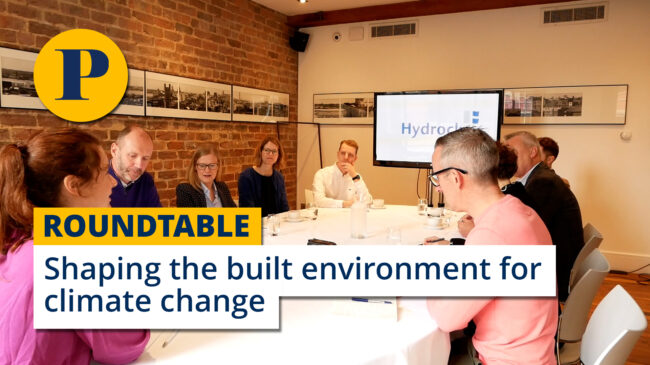PlaceEXPO: Low Carbon UK Summit
 A focus on the carbon efficiency of new-build properties risks ignoring the ticking 'time bomb' of historic building stock, speakers at the PlaceEXPO Low Carbon UK Summit warned.
A focus on the carbon efficiency of new-build properties risks ignoring the ticking 'time bomb' of historic building stock, speakers at the PlaceEXPO Low Carbon UK Summit warned.
Bill Chandler, legal director at Hill Dickinson, grabbed the attention of the audience with his talk 'Comply or die!' a compelling discussion of the reasons why businesses need to take the targets set by the Climate Change Act seriously. With the government committed to reducing carbon emissions by 80% by 2050 compared to 1990 output, and all new homes built as zero carbon by 2016, the time to act is now, said Chandler.
"It doesn't matter what side of the fence you are on and what you think about climate change, the international community is taking steps to deal with it from a legal perspective," he said. However, he acknowledged that the legislative landscape was not geared up to make compliance easy, and that the low carbon target was tougher to achieve than most realised.
"The built environment creates up to half of all emissions, and while there is a plethora of legislation, regulation and interventions designed to achieve targets, many people simply don't know what to do, are sceptical or are confused. The government keeps moving the goalposts, with schemes such as the feed-in tariff changing criteria frequently.
"We can make sure that what we build now is better than before, we can and are putting developers under specific obligations and we have created a code for sustainable homes.
"These actions are great, but the challenge is to hit the target by 2050, and we are faced with the fact that two-thirds of the building stock that we'll be using by then has already been built."
We must do more with existing buildings, Chandler said, but incentives for retrofitting current buildings were simply not there.
"We need to see tighter legislation," said Chandler. "The government could impose a staged process, but a minimum standard for energy emissions needs to be set now.
"There are three personas you can adopt. An ostrich, burying your head in the sand. A dustman, deciding to dump all of your stock as quickly as possible, or a Superhero Retrofit Man.
"Making a decision about energy emissions is not just about meeting government targets, it can create a bottom line saving."
The Low Carbon UK Summit was sponsored by the Low Carbon Innovation Hub at Liverpool John Moores University, Hill Dickinson, and Cheshire West & Chester Council.
Download slides below:
- Dr Stephen Finnegan, Liverpool John Moores University, Low Carbon Innovation Hub
- Bill Chandler, Hill Dickinson
- David Smith-Milne, PlaceFirst
Dr Stephen Finnegan, senior lecturer in building surveying, and sustainability lead at Liverpool John Moores University, gave an overview of low carbon technology development at the Low Carbon Innovation Hub, a European Regional Development Fund two-year project with a team of six working alongside university academics.
The focus, Finnegan said, was on low carbon technologies, environment management and clean technologies, and renewable energy. A key recent innovation in the sector was the use of sensors in building construction. Finnegan said that "ground breaking" discoveries had been made in the use of sensors for industrial use, with activation through microwaves. The flexible sensors had proved popular in the medical world for the monitoring of illnesses such as diabetes, but in a property context were being developed for use in a "smart brick", to measure factors in a building such as humidity and heat and help manage energy spend.
In terms of finance for low carbon activity, Finnegan highlighted the lack of long-term thinking in the sector, who didn't even seem motivated by the potential cost savings. He said: "There is not a consistent plan or forward thinking from businesses on this issue.
"Are we really prepared for the next five, 10, 15 years? Businesses are still unclear as to the next step, and are asking, should we just carry on as usual or should we really forward plan? They're still unsure of the risk that climate change really poses."
David Smith-Milne, managing director of PlaceFirst, discussed the developer's ethos when it comes to incorporating energy efficient systems as part of its refurbishment of empty homes.
PlaceFirst builds homes for private rent with a target audience of low-income working families, and those who would never expect to be able to own a home. Therefore, the affordability of the product was essential, Smith-Milne said, and was a key driver behind the company's motivation to use whatever resources they could find to ensure a property is cheap to live in.
PlaceFirst is currently on site with schemes valued at £25m, and is targeting another £25m in the next 12 months. Its tenant demographic can support a rent of between £482 and £879 a month, Smith-Milne said, which meant the budget for "all in" developments costs had to be between £87,000 and £132,000 if the asset was going to give a good yield.
Balancing the end product and construction costs was a constant tension, Smith-Milne said. "People try to push you to the lowest common denominator and the minimum requirement in terms of spend, but we want quality. We work in areas where there are low to middle income families, who are not benefit dependent, and face few renting options other than amateur landlords. As yields are low we need to work hard to drive down construction costs, but not at the compromise of the building.
"Things like the thermal fabric envelope need to last for 25 years at least. When it is to rent and not sell, you do become very concerned about the future-proofing of the property."
In schemes such as Woodnook, PlaceFirst's flagship empty homes refurbishment scheme in Accrington, energy efficiency was essential to control costs. The refurbished homes would be 60% cheaper to run, Smith-Milne said, which offers significant benefits to both landlord and tenant.
Questions to the panel at the end of the session raised issues such as the VAT policy on expenditure of retrofitting properties, funding streams for new technologies, and the fight against fuel poverty.




